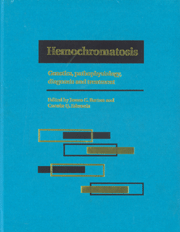Book contents
- Frontmatter
- Contents
- List of contributors
- Foreword
- Part I Introduction to hemochromatosis
- Part II Genetics of hemochromatosis
- Part III Metal absorption and metabolism in hemochromatosis
- Part IV Diagnostic techniques for iron overload
- Part V Complications of iron overload
- Part VI Therapy of hemochromatosis and iron overload
- Part VII Infections and immunity in hemochromatosis
- Part VIII Hemochromatosis heterozygotes
- Part IX Relationship of hemochromatosis to other disorders
- Part X Animal models of hemochromatosis and iron overload
- Part XI Screening for hemochromatosis
- Part XII Hemochromatosis: societal and ethical issues
- Part XIII Final issues
- 57 Hemochromatosis: problems to be solved and directions for future investigations
- Index
57 - Hemochromatosis: problems to be solved and directions for future investigations
from Part XIII - Final issues
Published online by Cambridge University Press: 05 August 2011
- Frontmatter
- Contents
- List of contributors
- Foreword
- Part I Introduction to hemochromatosis
- Part II Genetics of hemochromatosis
- Part III Metal absorption and metabolism in hemochromatosis
- Part IV Diagnostic techniques for iron overload
- Part V Complications of iron overload
- Part VI Therapy of hemochromatosis and iron overload
- Part VII Infections and immunity in hemochromatosis
- Part VIII Hemochromatosis heterozygotes
- Part IX Relationship of hemochromatosis to other disorders
- Part X Animal models of hemochromatosis and iron overload
- Part XI Screening for hemochromatosis
- Part XII Hemochromatosis: societal and ethical issues
- Part XIII Final issues
- 57 Hemochromatosis: problems to be solved and directions for future investigations
- Index
Summary
Introduction
At the conclusion of the First International Conference on Hemochromatosis in New York City in 1987, attendees discussed unsolved problems concerning hemochromatosis. One of the most important of these was identification of the hemochromatosis gene. Other questions that prevented an adequate understanding of hemochromatosis in 1987 included: Why is there a preponderance of males with hemochromatosis? What are the possible interactions of the hemochromatosis gene with X chromosomes? How does regulation of iron absorption differ between normal persons and those with hemochromatosis? What are the differences in iron transport in normal persons and in those with hemochromatosis? Why does iron loading of some organs occur in hemochromatosis, but there is little or no excess iron deposition in other cells and tissues, e.g., reticuloendothelial cells and organs? What are the mechanisms of iron-related tissue injury? Does hemochromatosis represent a constellation of disorders of iron absorption and metabolism?
Progress in understanding some features of hemochromatosis
A few of the questions posed in 1987 have been partially answered. Identification of the first hemochromatosisassociated gene (HFE), a class I-like gene linked to the major histocompatibility complex (MHC) on 6p, was published in 1996. Two mutations of HFE were reported: nt 845G→A (Cys282Tyr; C282Y) and nt 187C→G (His63Asp; H63D). Of these, the C282Y mutation is considered to be a major cause of iron loading. However, the results of multiple studies performed in several populations indicate that the clinical phenotype associated with Caucasian hemochromatosis can only be explained in all patients by the occurrence of multiple genes that cause increased iron absorption.
- Type
- Chapter
- Information
- HemochromatosisGenetics, Pathophysiology, Diagnosis and Treatment, pp. 583 - 588Publisher: Cambridge University PressPrint publication year: 2000

